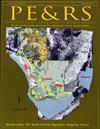一种从ICESat-2高程数据提取高精度高程控制点的方法
IF 2
4区 地球科学
Q4 GEOGRAPHY, PHYSICAL
引用次数: 11
摘要
星载激光测高技术由于测距精度高,可以在没有地面控制点的情况下提高卫星立体测图的精度。在过去,全波形ICE、CLOUD和陆地高程卫星(ICESat)激光高度计数据被用作全球高程控制的主要数据源之一。作为第二代卫星,ICESat-2配备了一个采用光子计数模式的高度计。这可以进一步提高立体测绘的应用能力,因为六束激光具有高的沿轨道重复频率,可以提供更详细的地面轮廓描述。以前的研究已经解决了如何从ICESat数据中提取高精度高程控制点的问题。然而,由于激光高度计的模式不同,这些方法不能直接应用于ICESat-2数据。因此,本文提出了一种利用综合评价标签的方法,从ICESat-2陆地-植被沿轨产品中提取满足大比例尺制图不同高程精度要求的高精度高程控制点。利用两组机载激光雷达数据对该方法进行了验证。在平坦、丘陵和山区,采用该方法提取地形高程后,高程控制点的均方根误差分别从1.249 ~ 2.094 m、2.237 ~ 3.225 m和2.791 ~ 4.822 m降至0.262 ~ 0.429 m、0.484 ~ 0.596 m和0.611 ~ 1.003 m。结果表明,提取的高程满足大比例尺制图的精度要求。本文章由计算机程序翻译,如有差异,请以英文原文为准。
A Method of Extracting High-Accuracy Elevation Control Points from ICESat-2 Altimetry Data
Due to its high ranging accuracy, spaceborne laser altimetry technology can improve the accuracy of satellite stereo mapping without ground control points. In the past, full-waveform ICE, CLOUD, and Land Elevation Satellite (ICESat) laser altimeter data have been
used as one of the main data sources for global elevation control. As a second-generation satellite, ICESat-2 is equipped with an altimeter using photon counting mode. This can further improve the application capability for stereo mapping because of the six laser beams with high along-track
repetition frequency, which can provide more detailed ground contour descriptions. Previous studies have addressed how to extract high-accuracy elevation control points from ICESat data. However, these methods cannot be directly applied to ICESat-2 data because of the different
modes of the laser altimeters. Therefore, in this paper, we propose a method using comprehensive evaluation labels that can extract high-accuracy elevation control points that meet the different level elevation accuracy requirements for large scale mapping from the ICESat-2 land-vegetation
along-track product. The method was verified using two airborne lidar data sets. In flat, hilly, and mountainous areas, by using our method to extract the terrain elevation, the root-mean-square error of elevation control points decrease from 1.249–2.094 m, 2.237–3.225 m, and 2.791–4.822
m to 0.262–0.429 m, 0.484–0.596 m, and 0.611–1.003 m, respectively. The results show that the extraction elevations meet the required accuracy for large scale mapping.
求助全文
通过发布文献求助,成功后即可免费获取论文全文。
去求助
来源期刊

Photogrammetric Engineering and Remote Sensing
地学-成像科学与照相技术
CiteScore
1.70
自引率
15.40%
发文量
89
审稿时长
9 months
期刊介绍:
Photogrammetric Engineering & Remote Sensing commonly referred to as PE&RS, is the official journal of imaging and geospatial information science and technology. Included in the journal on a regular basis are highlight articles such as the popular columns “Grids & Datums” and “Mapping Matters” and peer reviewed technical papers.
We publish thousands of documents, reports, codes, and informational articles in and about the industries relating to Geospatial Sciences, Remote Sensing, Photogrammetry and other imaging sciences.
 求助内容:
求助内容: 应助结果提醒方式:
应助结果提醒方式:


